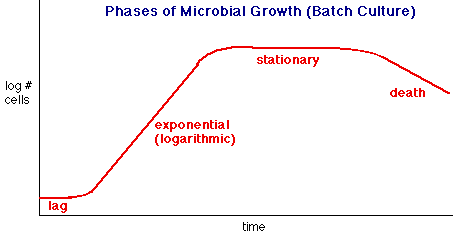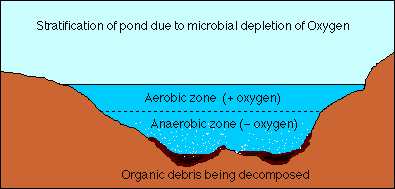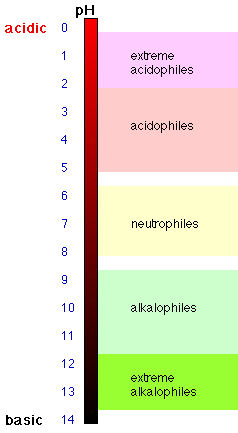|
|
Quiz Me! |
Microbial Growth |
|
|
|
Lecture Index | ||
|
|
Course Resources page |
Last revised: Wednesday, February 9, 2000
Ch. 6 in Prescott et al, Microbiology, 4th Ed.Note: These notes are provided as a guide to topics the instructor hopes to cover during lecture. Actual coverage will always differ somewhat from what is printed here. These notes are not a substitute for the actual lecture!Copyright 2000. Thomas M. Terry
- Today, look at phenomenon of GROWTH, how it is influenced by chemical & physical factors in environment.
- Understanding microbial growth is crucial to many industrial, health, and research considerations.
- For example: imagine you are hired by Pfizer to help develop new antibiotic from a strain of Bacillus. You have one 10,000 gallon tank available, costs $1000/day to run. You must decide how much inoculum to put in tank, when to harvest bacteria for maximum profit, minimum cost. How will you decide? What numbers do you need?
- Another example. You are hired as a research assistant in a laboratory. You need to grow bacteria to a concentration of 5 x 108 cells/ml, then harvest these cells for use in an experiment. When should you inoculate? How can you know when you have reached the desired cell concentration?
Batch vs. Continuous culture methods
- Batch method: put small inoculum of pure culture into sterile medium, let grow. Common lab procedure, but not typical of many real environments.
- Continuous culture (see text pp. 121-122): use chemostat or turbidostat. Trickle fresh medium into culture at slow but steady rate, displace = volume of culture as overflow. Cells remain in exponential (but suboptimal) state, growing at known rate. Good simulation for study of many natural environments.
Mechanics of batch growth.
- Prokaryotes grow by binary fission: 1 cell grows, divides into 2 identical daughters, etc.
- View movie of dividing E. coli
Growth curve (see Fig. 6.1 in text)
4 phases: lag, exponential, stationary, and death

- Whylag phase?
- Previous cells ran out of food, shut down many metabolic pathways needed for active growth, made adaptations necessary for dormancy and protection. Need to regenerate pools of essential nutrients before growth can resume, requires new enzyme synthesis and time for pathways to function.
- Can reduce or eliminate lag phase by using cells that are not in stationary phase.
- Why exponential phase?
- Cells in optimum growth state, divide repeatedly by binary fission at maximal rate.
- Note: useful to calculate doubling time; can vary from 20 min to several days
- Why stationary phase?
- Can be due to exhaustion of some critical nutrient, or to accumulation of waste products that slow down growth (e.g. acid buildup from fermentation).
- Why death phase?
- Continued accumulation of wastes, exposure to oxygen, loss of cell's ability to detoxify toxins, etc. Note that death is exponential; 90% of cells die in certain time, another 90% in same time period, etc.
- Note: in practice, try to prolong stationary phase, reduce death phase. Don't store cultures at room temperature on plates (ready exposure to oxygen, dessication, high temperature speeds oxidation reactions). Better, transfer to slants (tubes), store capped in refrigerator once grown. Still better, transfer to stab tube (soft nutrient agar), stopper and seal with airtight seal. Can recover viable culture even after a year of sitting on shelf!
Mathematics of growth; generation time
Growth equation
# of generations # of bacteria log2N log10N 0 1 or 20 0 0 1 2 or 21 1 .301 2 4 or 22 2 .602 3 8 or 23 3 .903 4 16 or 24 4 ... 5 32 or 25 5 ... n 2n n .301n 
Example:
- where n = number of generations
- Nf = final conc. of cells (e.g. 109/ml)
- No = initial conc. of cells (e.g. 103/ml)
- and .301 is factor to convert log2 to log10
Note: be able to calculate g.t. Pay attention to units, ask if your answer is reasonable.
measure culture at 9 a.m.: No = 10,000 cells/ml measure culture at 3 p.m.: Nf = 100,000 cells/ml calculate n = (5 - 4)/0.301 = 1/0.3 = 3.33 generations total time = 6 hours = 360 minutes 360 minutes/3.33 generations = 108 minutes/generation Conclude: generation time = 108 minutes Graphical measurement of growth
See text fig. 6.2Plotting # of cells vs. time gives a curved line.
Plotting log # of cells vs. time gives a straight line -- easier to interpolate, use.
Plotting # of cells vs time on semilog paper also gives a straight line -- easiest way in practice to work with growth measurements.
Note: often what is plotted on the Y-axis of semilog paper is not # of cells, but something more easily measurable, such as Absorbance (see below).
Measurement of growth
- Total Cell count
- Petroff-Hausser chamber slide -- needs large conc. (107 cells/ml minimum) -- see Fig. 6.4
- Coulter Counter (for larger microbes; fungi, yeasts, protozoa, etc.) -- uses electrical charge difference in passing through small hole. Not so useful with bacteria, get errors due to clumping, debris, etc.
- Viable count
- This is typically carried out by CFU (colony forming units) assay:
- carry out dilution series
- plate known volumes on plates
- count only plates with 30-300 colonies (best statistical accuracy)
- extrapolate to undiluted cell conc.
- CFU may or may not be same as number of cells --
- Method is accurate, but requires time for incubation.
- Two ways to carry out viable count:
- Spread plate: bacteria are spread on the surface of agar using some sterile spreading device.
- Advantages: if properly carried out, all colonies should be easily counted.
- Disadvantages: takes some time, not always reliable in inexperienced hands, cells with low tolerance to oxygen won't grow. If "spreaders" are present, may overgrow plate surface.
- Pour plate: bacteria are mixed with melted agar and cooled; colonies grow throughout the agar.
- Advantages: almost fail-proof technique, colonies well separated. Can allow growth of organisms with lower oxygen tolerance in agar.
- Disadvantages: colonies variable size, harder to see similarity in colony morphology between those on surface and in agar. Counting may be more difficult. Heat may kill some cells before agar cools and gels.
- Optical techniques
- Often, can estimate cell numbers accurately by measuring visible turbidity. Light scattered is proportional to number of cells.
- This only works above cell densities of 107 in pure cultures. With less than 107 cells/ml, cannot detect bacteria.
- Eyeball method. This is not a precise measurement, but shoud allow estimation within an order of magnitude
- no turbidity means less than 107 cells/ml
- slight turbidity = 107-108 cells/ml
- high turbidity = 108-109 cells/ml
- Very high turbidity = greater than 109 cells/ml (cultures rarely get as high as 1010 cells/ml)
- Absorbance method
- Use a spectrophotometer to accurately measure absorbance, usually at wavelengths around 400-600 nm.
- Accurate measure of cells when concentration not too high. Easy and quick to measure (can sample in less than a minute)
Effects of temperature on growth
- Higher temperatures speed up chemical reactions, ~ double rate for every 10 deg. C in temperature.
- Expect cells to grow more rapidly as temp. rises, up to a point. But too high temperatures denaturation of proteins and nucleic acids, loss of critical enzymes and loss of metabolism.
- Cardinal temperatures: every organism can be characterized by thee temperatures: (see Table 6.5 for examples)
- minimum temperature, below which no growth occurs
- optimum temperature, at which fastest growth occurs
- maximum temperature, above which no growth occurs
Different microbes adapted to different temperature ranges
- Typical bacterium can grow over ~ 30 deg. C temp. range (stenothermal); some can grow over wider range (eurythermal).
- Psychrophiles -- optimum temp. typically 15 deg C or lower. Note: some organisms are psychrotolerant -- optimum temperature is 20-40 deg, but can grow as low as 0 deg. These are not considered psychrophiles.
- Mesophiles -- optima from 20-45 deg, minimum around 15-20 deg.
- Thermophiles -- optima 55 deg or higher. Some (hyperthermophiles) have optima of 80 deg or higher (mostly Archaea in this group). Found in hot springs, deep-sea hydrothermal vents, other locations.
- Physiological and structural adaptations are related to temperature:
- psychrophiles produce enzymes with lower temperature optima. They often denature at room temperatures.
- psychrophiles have higher unsaturated fatty acids in membrane lipids, keeps membranes fluid at lower temperatures.
- thermophiles have enzymes that are heat stable, also ribosomes work at higher temps. Only a few amino acid changes from mesophile proteins seem necessary in some cases to allow high temperature stability. Also more salt bridges in proteins.
- thermophile membranes have many long-chain fatty acids, lots of saturated fatty acids. membrane lipids "freeze" into solid form at what we would consider warm temperatures, thus inhibiting transport. But at very high temperatures, membranes function well.
Effects of oxygen on growth
Note: higher organisms all require oxygen; we are not used to thinking about other alternatives. But many microbes grow anaerobically some or all of the time.Terminology
- Obligate aerobes -- grow only when oxygen is present
- Facultative anaerobes -- grow with or without oxygen, grow better in oxygen (respire)
- Aerotolerant anaerobes -- ignore oxygen, grow equally well with or without
- Obligate anaerobes -- die in presence of oxygen
- Microaerophiles -- won't grow at normal atmospheric oxygen (20%), but require some oxygen for growth (2-10%)
Anaerobic habitats more common than expected. Ex: in human mouth, plaque contains bacterial zoo. Facultative anaerobes consume oxygen, create anaerobic microenvironment fit for obligate anaerobes.In general, wherever organic matter accumulates, microbes will use up oxygen faster than it can be replaced, create anaerobic environment. Esp. true under water, since oxygen is poorly soluble in water. Lakes and ponds stratify into aerobic (upper) and anaerobic (lower) zones in summer due to vigorous microbial growth on sediments.
Why obligate anaerobes?
Oxygen itself is reactive (oxidizing agent), capable of degrading organic molecules. But oxygen can easily generate very toxic byproducts, strong oxidizing agents that react indiscriminately with any organic molecules, including DNA, proteins, etc.:
- superoxide (O2-)
- peroxide (H2O2
- hydroxyl radical (OH.)
Aerobes (and all cells able to tolerate oxygen) must have enzymes to get rid of these radicals. Superoxide dismutase and catalase are two crucial enzymes.superoxide (O2-)+ H+ ---(superoxide dismutase)----> O2 + H2O2 peroxide (H2O2) ---(catalase)------> O2 + H2ONote: If E. coli (a facultative anaerobe) is mutated so it loses these two enzymes, resulting mutant behaves like an obligate anaerobe -- good confirmation of idea.Culture techniques
- for aerobes: shake or rotate culture to add more oxygen, or bubble filtered air through culture
- for anaerobes: use media with reducing agent (combines with oxygen chemically)
pump out air, flush with pure nitrogen gas GasPak jar, seal plates in jar, use catalyst + hydrogen gas to remove oxygen
Effects of pH on growth
Diff microbes have diff pH optima:
- pH measures acidity. pH = log 10 of H+ concentration.
- Pure water has pH of 7; 1 molar acid pH = 0. See figure 6.13 in text

- Acidophiles = acid pH optimal (1 to 5.5)
- Neutrophiles = pH 5.5 to 8 optimal
- Alkaliphiles = pH 8.5 to 11.5
- Extreme alkaliphiles = optimum pH 10 or greater
- Note: most bacteria are neutrophiles (Exceptions: some bact in hot springs have optimum of 1-3)
- But most fungi prefer slight acid (pH 4 to 6)
- Saboraud's Medium (in lab this week) -- uses low pH to stop bacterial growth, selective for fungal growth.
Effects of solutes and water activity on growth
- Cells require certain amount of free water to be able to carry out metabolism. When placed in hypertonic environments, many cells stop growing.
- Some can compensate, synthesize compatible solutes (= molecules whose function is to balance osmotic strength). Examples: choline, proline, betaine, glutamic acid, etc.
- Staphylococci are good examples; grow on skin, where salts are common. Staph can tolerate up to 10% salt; can design culture media with 7.5% salt, suppress growth of most other bacteria, select for Staph (will do this in lab later on this semester)
- Some bacteria require very high osmotic strengths for growth = Halophiles; Ex. Halobacterium halobium grows in Dead Sea, Great Salt Lake, evaporating salt flats. Won't grow if salt concentration much less than 3M!
- Note: these are members of Archaea; have very modified cell walls and membranes. Accumulate enormous amounts of potassium as compatible solute.
Effects of radiation on growth
- Light and UV are parts of EM spectrum; extends to very strong radiation (gamma rays), very weak radiation (heat, radio)
- Visible light (esp. more energetic violet and blue) are quite strong, can kill bacteria. Many bacteria that are spread by air are pigmented; pigments adsorb radiation, prevent damage to cell.
- Note: pigment-less mutant shows much more sensitivity to light than pigmented form.
Mechanisms of damage:
- light adsorbed by some pigment (e.g. cytochrome, flavin, chlorophyll), energy transferred to oxygen to generate singlet oxygen = very strong oxidizing agent, causes lots of damage
- UV light causes specific damage to DNA, max. effect at 260 nm --> thymine dimers
- Ionizing radiation causes many types of damage: breaks H-bonds, oxidizes many groups, can break DNA strands (most vulnerable target).
Take a Self-Quiz on this material
Return to Lecture Index
Return to MCB 229 Course Resources page